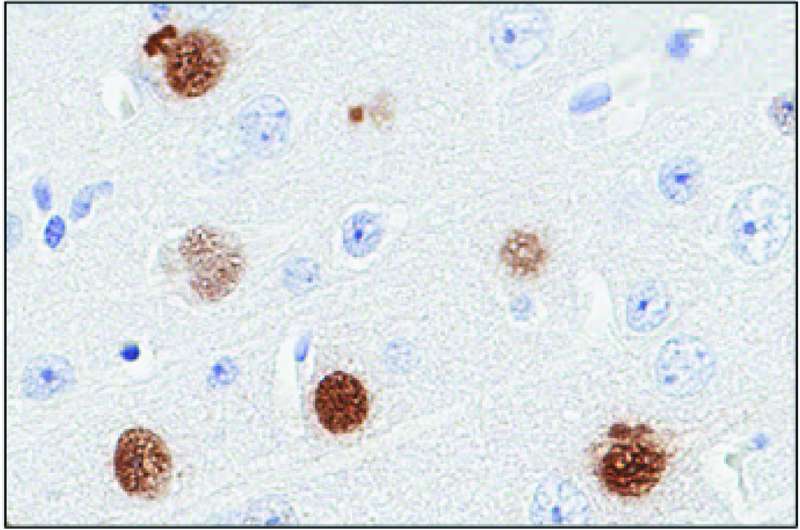March 30, 2017 report
Possible genetic marker for ALS found might prove useful for measuring effectiveness of treatments

(Medical Xpress)—A very large team of researchers with members from the U.S., Italy and the Netherlands has found what might be a marker for ALS, which the team suggests could be used as a yardstick for measuring the effectiveness of treatments in clinical trials. In their paper published in the journal Science Translational Medicine, the team describes how they connected a genetic abnormality common in ALS patients with a protein they found in blood cells and cerebrospinal fluid.
Amyotrophic lateral sclerosis (ALS), aka Lou Gehrig's disease, is a disorder that causes nerve degeneration leading to muscle atrophy and eventually death. To date, there is no known cure, though one drug has been found to delay the progression of the disease for a few months. One of the things standing in the way of a cure is a lack of tests that can tell researchers if a treatment under study is having any discernable positive impact. This is because there is no test for the disorder itself. In this new effort, the researchers believe they may have found a marker that could be used to test for the disorder, and more importantly, serve as a means for measuring whether a drug developed to reduce symptoms, or better yet a cure for the disease, actually does what is hoped.
The researchers started by looking at patients with a gene mutation called C9ORF72 which is believed to be behind the onset of most types of genetically caused ALS (and also some types of dementia.) During their research, they discovered that many such patients had more than normal amounts of a protein called polyGP in their cerebrospinal fluid and also in their blood cells. Inspired, they conducted a study comparing patients with polyGP in their cerebrospinal fluid with those that had the mutation and with control groups.
The team reports that they found the protein buildup in 134 people who had the mutation, which included 83 people who had ALS, 27 people who had no symptoms, and 24 people who had other types of diseases. Furthermore, they found that the protein buildup was not found in 120 people who did not have the mutation, including those with different types of ALS.
These findings, the group suggests, mean that testing for polyGP might someday soon be used as a viable way to measure treatment success, which could perhaps one day lead to better therapies or perhaps a cure.
More information: Tania F. Gendron et al. Poly(GP) proteins are a useful pharmacodynamic marker for-associated amyotrophic lateral sclerosis, Science Translational Medicine (2017). DOI: 10.1126/scitranslmed.aai7866
Abstract
There is no effective treatment for amyotrophic lateral sclerosis (ALS), a devastating motor neuron disease. However, discovery of a G4C2 repeat expansion in the C9ORF72 gene as the most common genetic cause of ALS has opened up new avenues for therapeutic intervention for this form of ALS. G4C2 repeat expansion RNAs and proteins of repeating dipeptides synthesized from these transcripts are believed to play a key role in C9ORF72-associated ALS (c9ALS). Therapeutics that target G4C2 RNA, such as antisense oligonucleotides (ASOs) and small molecules, are thus being actively investigated. A limitation in moving such treatments from bench to bedside is a lack of pharmacodynamic markers for use in clinical trials. We explored whether poly(GP) proteins translated from G4C2 RNA could serve such a purpose. Poly(GP) proteins were detected in cerebrospinal fluid (CSF) and in peripheral blood mononuclear cells from c9ALS patients and, notably, from asymptomatic C9ORF72 mutation carriers. Moreover, CSF poly(GP) proteins remained relatively constant over time, boding well for their use in gauging biochemical responses to potential treatments. Treating c9ALS patient cells or a mouse model of c9ALS with ASOs that target G4C2 RNA resulted in decreased intracellular and extracellular poly(GP) proteins. This decrease paralleled reductions in G4C2 RNA and downstream G4C2 RNA–mediated events. These findings indicate that tracking poly(GP) proteins in CSF could provide a means to assess target engagement of G4C2 RNA–based therapies in symptomatic C9ORF72 repeat expansion carriers and presymptomatic individuals who are expected to benefit from early therapeutic intervention.
© 2017 Medical Xpress



















